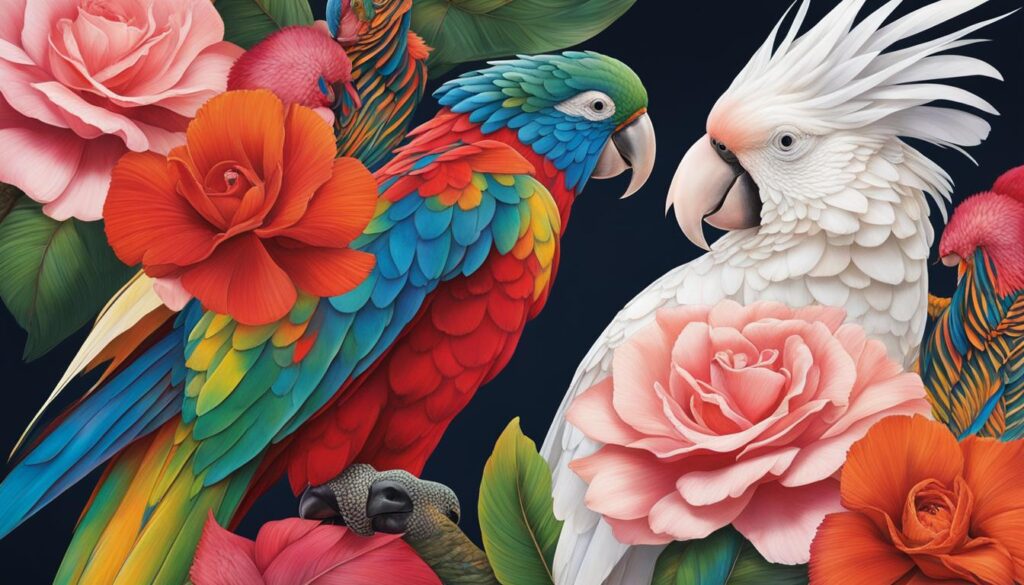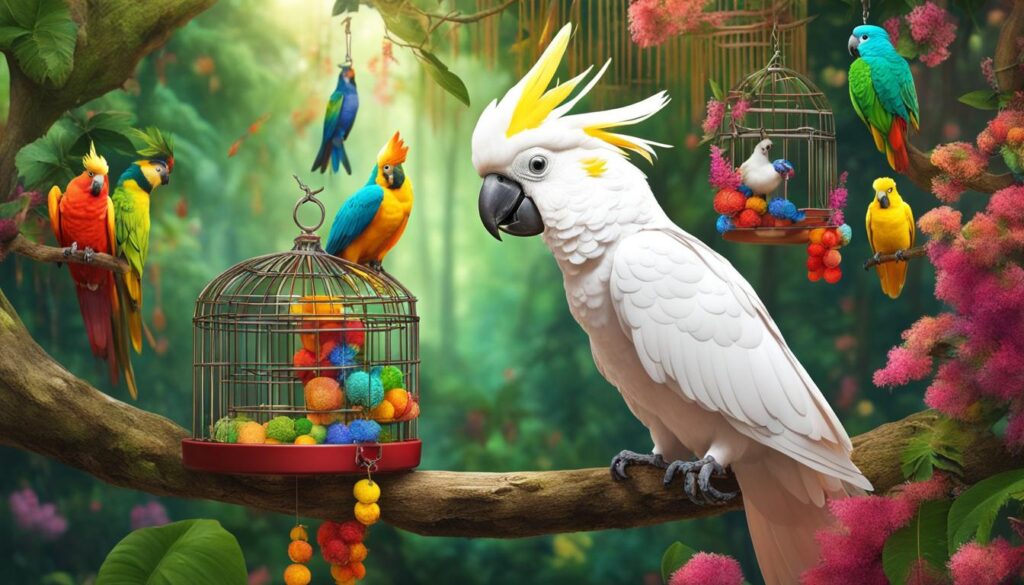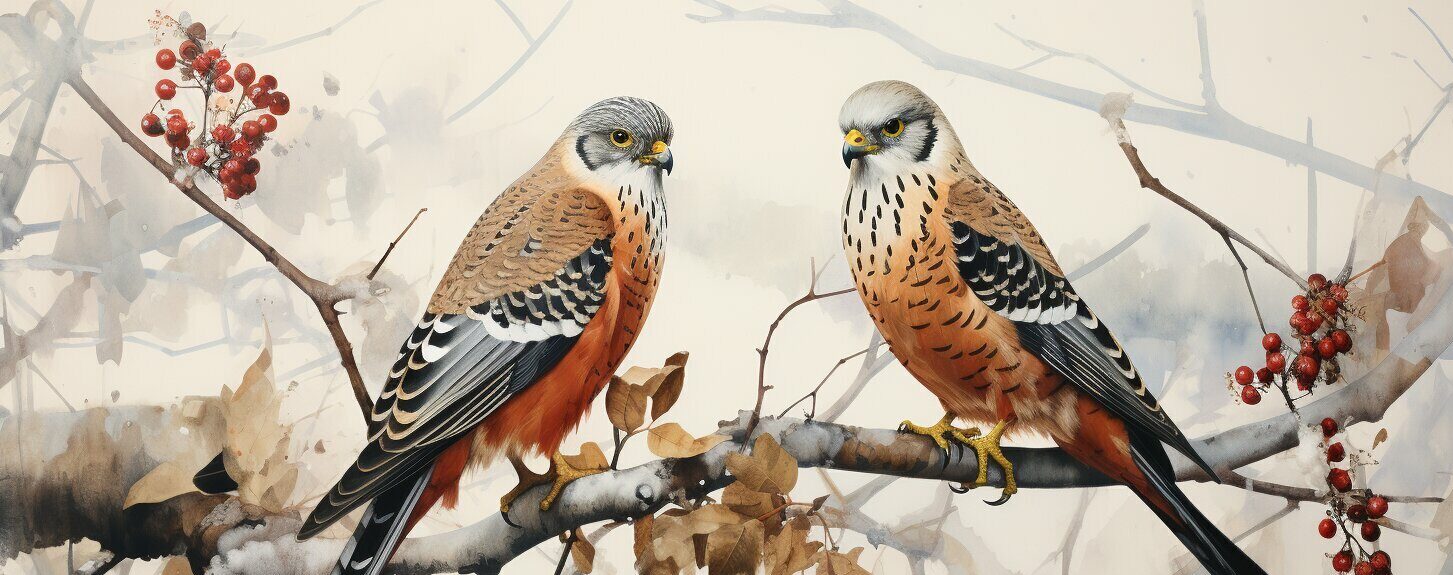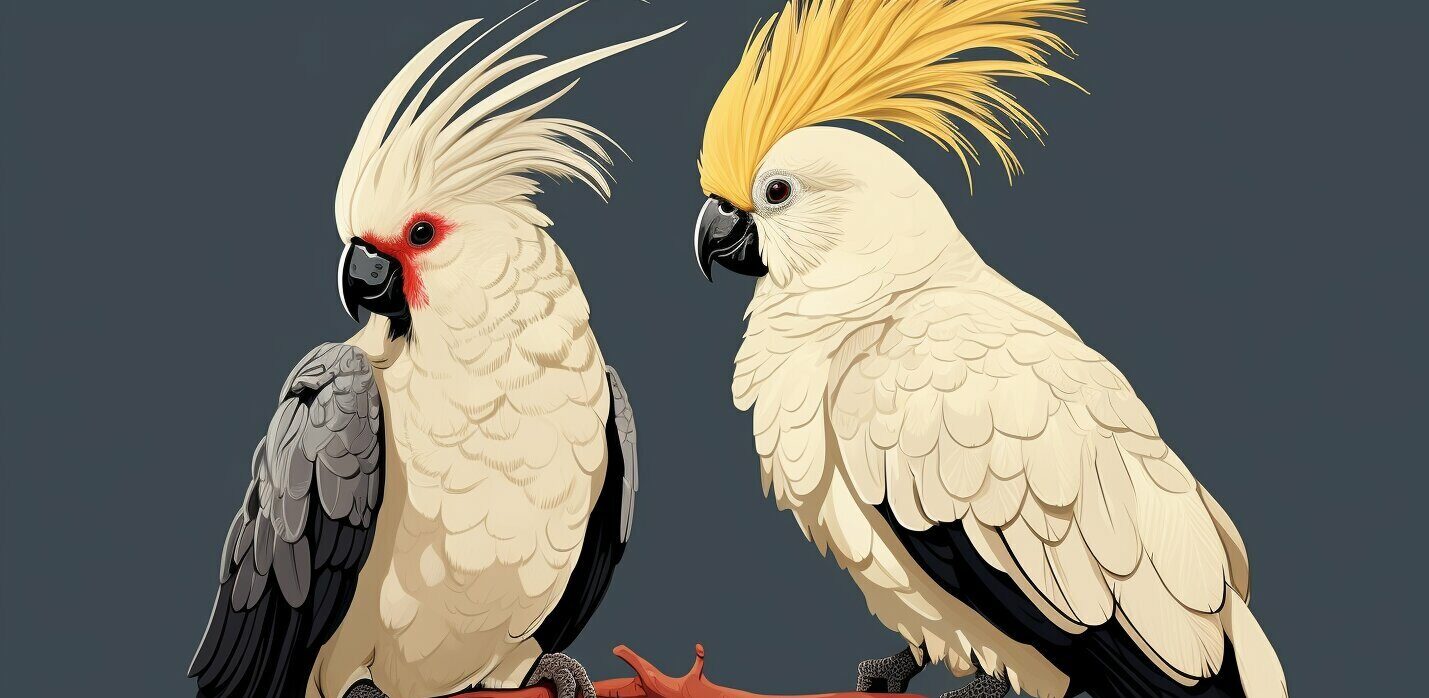Welcome to our comprehensive pet guide that explores the fascinating world of parrots and cockatoos. If you’re considering adding a pet bird to your household, it’s essential to understand the differences between these two popular avian companions. In this guide, you’ll learn about their distinctive characteristics, dietary needs, and behavior patterns, helping you make an informed decision on which bird may be the perfect addition to your family. So, let’s dive into the colorful and charismatic world of these captivating creatures.
Key Takeaways
- Understand the primary differences between parrots and cockatoos as potential pet companions.
- Explore the various species within the parrot family and their unique traits.
- Learn about the specific dietary needs and feeding habits of parrots and cockatoos.
- Discover the behavioral traits, sociability, and interaction levels of these avian pets.
- Gain insight into the long-term care and commitment required to own a pet bird with a long lifespan.
Understanding the Parrot Family and Cockatoo Distinction
Parrots, scientifically known as Psittacine, are a group of incredibly diverse and fascinating birds. Comprising over 400 species, they come in all shapes, sizes, and colors. Within the extensive parrot family, we find a distinctive subgroup called the cockatoos. To truly appreciate the myriad of parrot species and the cockatoo distinction, let us explore their unique characteristics, classifications, and specific bird care practices that potential bird owners should keep in mind.
The parrot family can be split into two main groups: the Psittacidae (true parrots) and the Cacatuidae (cockatoos). While cockatoos share some similarities with the rest of the parrot species, they possess certain traits that set them apart. The most noticeable difference is the unmistakable crest found atop the heads of all cockatoos – a feature absent in other parrot species.
- True parrots (Psittacidae)
- Macaws
- African Grey
- Amazons
- Conures
- Ring-necked Parrots
- Sulphur-crested Cockatoos
- Galahs
- Black Palm Cockatoos
- Cockatiels
- Goffin’s Cockatoos
Common parrot species vary significantly in size, color, and habitat, while cockatoos tend to be larger in comparison. Some examples of parrot species include the Macaws, African Greys, and Amazons, while cockatoo species feature the striking Sulphur-crested Cockatoos, the vibrant pink Galahs, and the smaller-sized Cockatiels.
Beyond appearance, these bird species also exhibit unique native ranges, behavioral traits, and dietary preferences. Bird care practices must be tailored to cater to the specific needs of each species, ensuring a comfortable and nurturing environment for the bird. An essential factor to consider for the potential bird owner is educating yourself on proper bird care techniques for your chosen species, be it a parrot or a cockatoo.
| Parrot species | Cockatoo species |
|---|---|
| Macaws, African Greys, Amazons | Sulphur-crested Cockatoos, Galahs, Cockatiels |
| Smaller to medium-sized | Medium to large-sized |
| No crest | Distinctive crest on the head |
| Variety of native habitats and ranges | Mostly native to Australia and nearby regions |
| Bright and diverse colors | Primary colors: white, gray, black, and shades of pink |
| Diet tends to be more varied and fruit-based | Diet often consists of seeds, nuts, and plants |
In summary, the parrot family encompasses a vast array of eye-catching and interesting bird species, including the distinguished cockatoo subgroup. Gaining an in-depth understanding of the distinct characteristics and bird care requirements of both parrot species and cockatoo species will ensure proper care and a happier, healthier pet bird experience.
Physical Characteristics of Parrots and Cockatoos
Understanding the physical characteristics of parrots and cockatoos is essential for potential bird owners. These traits play a significant role in determining the compatibility of a bird with different living environments, as well as their unique visual appeal and care needs. In this section, we will discuss size and shape variations, feather coloring and markings, and distinguishing features unique to cockatoos.

Size and Shape Variations
Parrot species come in various sizes and shapes, ranging from the small and streamlined lovebirds to the large and impressive macaws. Cockatoos, on the other hand, are generally medium to large-sized birds with markedly robust body structures; the smallest cockatoo species is the Goffin’s cockatoo, averaging around 12 inches in length. The differences in size and shape can greatly affect the birds’ suitability for various living environments and may influence the appropriate cage size, perches, and toys for pet parrots and cockatoos.
Feather Coloring and Markings
One of the most attractive aspects of these avian species is their stunning plumage, which comes in a plethora of colors and patterns. Some of the most popular parrot species known for their vibrant feathers include the African Grey, Blue-and-Gold Macaw, and the Green-Cheeked Conure. In comparison, cockatoos generally exhibit a more monochromatic color palette, with most species being primarily white, gray, or black with vivid splashes of color under their wings or on their crests.
Feather coloring and markings can be indicative of species, age, and even mood. For example, younger birds may have duller colors than adults, while mood can be conveyed through feather ruffling or puffing. A bird’s diet can also affect its feather quality and color, emphasizing the importance of providing a balanced parrot diet to maintain their vibrant appearance.
Distinguishing Features Unique to Cockatoos
One of the most notable distinguishing features of cockatoos is the distinctive crest they possess, which can be raised or lowered depending on the bird’s mood and level of excitement. This crest is not present in other parrot species and sets cockatoos apart from their avian cousins. The use of this crest for communication and emotional expression is fascinating to observe and adds to the appeal of owning one of these birds.
Other differences include variations in beak and foot structure. While parrots typically have a hooked bill for manipulating food and climbing, cockatoos have a shorter, more rounded beak designed for crushing seeds and nuts. Additionally, cockatoos tend to have larger, more powerful feet, adapted for gripping branches and perches with ease.
In conclusion, understanding the physical characteristics of parrots and cockatoos can help potential bird owners make informed decisions about which species may be the best fit for them. Observing and appreciating the diversity in size, shape, and coloration, as well as the distinguishing features of these birds, can enrich the experience of owning one of these fascinating avian companions.
Natural Habitats: Parrot vs. Cockatoo Environments
Understanding the natural environments of parrots and cockatoos is essential for providing the appropriate bird care and living conditions for these fascinating creatures. Parrots and cockatoos naturally originate from different habitats, influencing their dietary, social, and behavioral preferences when kept as pets. Let’s explore the diverse landscapes these species call home and how these habitats impact their care needs in domestic settings.
Parrot Habitat
Parrots inhabit a range of environments, from tropical rainforests to savannas and even semi-arid regions. Although their habitat preferences vary, most parrot species favor forested areas due to the abundance of food, shelter, and nesting opportunities. These vibrant birds can be found in Central and South America, Africa, Asia, and Australia. Some familiar parrot species and their habitats include:
- African Grey Parrots – West and Central African rainforests
- Macaws – Central and South American rainforests
- Amazon Parrots – South American rainforests and savannas
- Budgerigars – Australian arid and semi-arid regions
Cockatoo Habitat
Cockatoos, despite being a part of the parrot family, have distinct living environments. Though these captivating birds are native to Australia, they also reside in parts of Indonesia and the Philippines. The cockatoo species tend to inhabit a variety of ecosystems, including:
- Rainforests
- Woodlands
- Eucalyptus groves
- Savannas
In captivity, it is crucial to replicate the natural habitat of parrots and cockatoos to ensure their contentment and wellbeing. Factors to consider for bird care include:
- Humidity levels appropriate for the species
- Adequate space to move and exercise
- Enrichment opportunities, such as toys and foraging spots
- Access to natural sunlight
| Parrot Habitat in Captivity | Cockatoo Habitat in Captivity |
|---|---|
| Spacious cage or aviary with horizontal bars for climbing | Large cage or aviary with both horizontal and vertical bars |
| Appropriate humidity and temperature levels based on species | Adapted to a wider range of temperatures but still require species-specific humidity |
| Variety of toys and branches for climbing and chewing | Selection of durable and engaging toys for chewing and play |
| Perch diversity in size, shape, and material | Multiple perches of varying sizes and materials |
Recreating these natural elements in a domestic setting is vital for both the physical and mental wellbeing of your pet birds. With the proper care and understanding of their original environments, you can provide the essential bird care your parrot or cockatoo species needs to thrive.
Behavioral Traits: Comparing Parrot and Cockatoo Personalities
Understanding the personalities and behavioral traits of parrots and cockatoos can help potential pet owners decide which bird is the right companion for them. This section delves into the sociability, interaction with humans, noise level, vocalization differences, and body language of these charming creatures.
Sociability and Interaction with Humans
Both parrots and cockatoos are known for their sociability and ability to bond with humans. These birds thrive on social interaction, and their behavior is highly influenced by their relationship with their human caretakers. In general, cockatoos are more affectionate and demand more attention than parrots, often seeking physical contact with their owners. Parrots, on the other hand, usually display a more independent nature and are content with playful interactions and verbal communication. A parrot’s relationship with its owner is highly influenced by its bird care and socialization, which can greatly impact their trust and willingness to engage in social behaviors.
Noise Level and Vocalization Differences
When it comes to noise level, there are significant differences between parrots and cockatoos. Cockatoos are generally louder, with vocalizations that can be quite raucous and demanding. On the other hand, parrots, although also capable of producing loud calls, tend to have a wider variety of vocalizations and mimicry skills. It is important for potential pet bird owners to consider the noise level and vocalization differences of these birds, as they can greatly impact their living environment and quality of life.
Body Language and Behavioral Cues
Both parrots and cockatoos communicate through their body language and behavioral cues. Observing their postures and movements can help owners better understand their pet’s feelings and needs. Below is a quick comparison of common body language and behavioral cues in parrots and cockatoos:
| Body Language /Behavioral Cues | Parrots | Cockatoos |
|---|---|---|
| Preening | Sign of contentment and relaxation. | Sign of contentment, grooming, and bonding when preening their human caretakers. |
| Raised Crest | N/A | Sign of excitement, curiosity, or aggression. Requires careful observation of the overall context to assess the situation accurately. |
| Eye Pinning | Sign of excitement or agitation. Owners should proceed with caution depending on the situation. | Sign of excitement, curiosity, or agitation. As with parrots, owners should proceed with caution and observe the context. |
| Tail Fanning | Sign of excitement or aggression. Proceed with caution. | Sign of excitement, curiosity, or aggression. As with parrots, require careful observation and caution from their human caretakers. |
Understanding and recognizing the body language and behavioral cues of parrots and cockatoos can greatly improve the bond between the bird and its owner, leading to a more harmonious and enjoyable pet bird experience.
Dietary Needs of Parrots versus Cockatoos
When it comes to the health and wellbeing of parrots and cockatoos, providing a balanced and nutritionally appropriate diet is paramount. The dietary preferences and nutritional requirements of these pet birds can vary between species, so it is important to understand the key differences in feeding habits, food preferences, and any special dietary requirements to ensure your feathered companion thrives.
Feeding Habits and Food Preferences
Both parrots and cockatoos are primarily herbivores, although they may consume some insects and animal proteins in the wild. However, there are certain differences in the feeding habits and food preferences of these birds. The following table presents a comparative overview of the typical diet for both pet parrots and cockatoos:
| Parrots | Cockatoos | |
|---|---|---|
| Seeds | Small amounts as occasional treats | Limited amounts (prefer specific varieties) |
| Pellets | Quality pellets should form the majority of their diet | Moderate amount of low-fat pellets |
| Fruits | Daily (pay attention to sugar content) | Daily (avoid high-sugar fruits) |
| Vegetables | Daily (leafy greens, carrots, peppers, etc.) | Daily (leafy greens, cruciferous veggies, etc.) |
| Nuts | In moderation | Occasional treats (but not for all species) |
| Insects | Rarely (mealworms, crickets, etc.) | Rarely (mealworms, crickets, etc.) |
Both parrots and cockatoos appreciate variety in their diets, and it is important to introduce them to different foods to help them enjoy a well-rounded diet.
Understanding Special Dietary Requirements
While the tables above outline the general dietary guidelines for parrots and cockatoos, there are some species-specific differences in their nutritional requirements. For optimal bird care, it is essential to research and cater to these unique needs, as they can impact your bird’s overall health and wellbeing.
- Amazon Parrots: Require a higher proportion of fruits and vegetables and can be prone to obesity if given too many seeds and nuts.
- African Grey Parrots: Need extra calcium in their diet, which can be provided through cuttlebone, mineral blocks, or calcium-fortified pellets.
- Eclectus Parrots: Require a diet rich in vitamin A, which can be supplied through foods like carrots, sweet potatoes, and leafy greens.
- Palm Cockatoos: Require relatively higher amounts of nuts in their diet compared to other cockatoo species.
- Moluccan Cockatoos: More prone to obesity, so they require a low-fat diet with limited amounts of seeds and nuts.
By understanding the specific dietary preferences and nutritional requirements of your pet bird, you can provide the best possible bird care, ensuring a long, healthy, and happy life for your parrot or cockatoo companion.
Cockatoos and Parrots as Pets: Lifespan and Long-Term Care
When considering a cockatoo or a parrot as a pet bird, it is essential to be aware of their cockatoo lifespan and the long-term care requirements these birds need. Both parrots and cockatoos can live for several decades, with some species even reaching up to 60 years of age. This long lifespan necessitates a substantial commitment from the owner in terms of time, resources, and emotional investment. In this section, we will discuss the expected lifespans of these birds and the aspects of long-term care you should consider as a responsible pet owner.

Expected Lifespan of Parrots and Cockatoos
The lifespan of a pet bird depends on various factors such as species, genetics, diet, and overall care. However, both parrots and cockatoos are generally known for their long lifespans, with many species living well into their 20s, 30s, and even beyond.
| Species | Average Lifespan |
|---|---|
| Budgerigar | 5-8 years |
| Cockatiel | 15-20 years |
| African Grey Parrot | 40-60 years |
| Blue and Gold Macaw | 30-50 years |
| Sulphur-Crested Cockatoo | 40-60 years |
Aspects of Long-Term Care
Long-term care for parrots and cockatoos encompasses numerous aspects, including:
- Veterinary care: Regular checkups and vaccinations with an avian veterinarian are essential to maintain the health of your pet bird. Additionally, be prepared to address any injuries or illnesses that may arise over time.
- Dietary needs: Providing a balanced diet with a variety of fresh fruits, vegetables, and high-quality pellets helps ensure your bird’s long-term health and happiness.
- Mental stimulation and social interaction: As highly intelligent and social animals, both parrots and cockatoos require plenty of interaction with their human family and a stimulating environment to thrive. Daily playtime, training sessions, and a variety of toys can help keep them mentally engaged.
- Housing and maintenance: A spacious, clean, and safe living environment is necessary for your pet bird’s wellbeing. This includes a large, sturdy cage, regular cleaning, and the use of safe, non-toxic materials.
- Aging considerations: As your pet bird ages, be prepared to make necessary modifications to their care, such as adjusting their diet or accommodating mobility issues.
Becoming a responsible parrot or cockatoo owner means committing to the long-term care and well-being of your pet bird. With proper care and a supportive environment, these magnificent creatures can be a rewarding and cherished addition to your family.
Conclusion
Throughout this article, we have explored the Difference Between Parrots and Cockatoos, allowing readers to understand both the similarities and variances between these fascinating bird species. From their physical characteristics to their unique natural habitats, the world of parrots and cockatoos is filled with vibrant color and personality.
As potential bird owners, it is essential to become acquainted with the behavioral traits, dietary needs, and long-term care requirements of your chosen feathered companion. By addressing these aspects and putting an emphasis on bird care and welfare, you can ensure a mutually enriching and joyful relationship with your pet.
Ultimately, selecting the right pet bird comes down to personal preference and aligning your lifestyle with the specific needs of either a parrot or a cockatoo. However, what remains constant is the commitment to responsible and informed pet ownership. Armed with the knowledge presented in this pet guide, you can make the best choice for you and your future avian friend, creating a happy and loving home together.
FAQ
What are the primary differences between parrots and cockatoos?
While both parrots and cockatoos belong to the same bird order, Psittaciformes, cockatoos are a distinct family within that order. They have unique physical features like a crest, and their personalities and social dynamics may differ from other parrot species. The colors of their feathers, their size and shape, and their natural habitats also vary between parrots and cockatoos.
How do the sizes and shapes of parrots and cockatoos differ?
There is a vast range in sizes and shapes among parrot and cockatoo species. The body length and wingspan of these birds can vary greatly, affecting their suitability for different living environments. Most parrots have a more streamlined body shape, while cockatoos are generally rounder and more robust.
What are some distinguishing features of cockatoos?
Cockatoos have a prominent crest on their head, which is used for communication and emotional expression. They also have rounder bodies and less vibrant feather colors, typically in shades of white, black, and gray, with some species featuring subtle pink or yellow undertones.
How do the natural habitats of parrots and cockatoos differ?
Parrots are native to tropical and subtropical regions around the world, while cockatoos are primarily found in Australia and nearby islands. The natural environments of these birds can affect their behavior and care requirements when they are kept as pets.
What are some key behavioral differences between parrots and cockatoos?
Parrots and cockatoos can differ in sociability, interaction with humans, noise level, and vocalization patterns. While both types of birds are social and require interaction, some parrot species may be more talkative and mimic human speech, while cockatoos tend to be more expressive using their crest and body language.
What should I feed my parrot or cockatoo?
A balanced diet for parrots and cockatoos includes a mix of pellets, seeds, fruits, vegetables, and nuts. Some birds may have specific dietary preferences or requirements depending on their species. It’s important to consult with a veterinarian or avian specialist to ensure optimal nutrition for your pet bird.
What is the average lifespan of parrots and cockatoos?
The lifespan of parrots and cockatoos can vary widely depending on the species. Some smaller parrots may live for 15 to 20 years, while larger parrots and cockatoos can live for 40 to 60 years or even longer. Owning a pet bird with a long lifespan requires a significant commitment to their long-term care and emotional wellbeing.
 Skip to main content
Skip to main content


